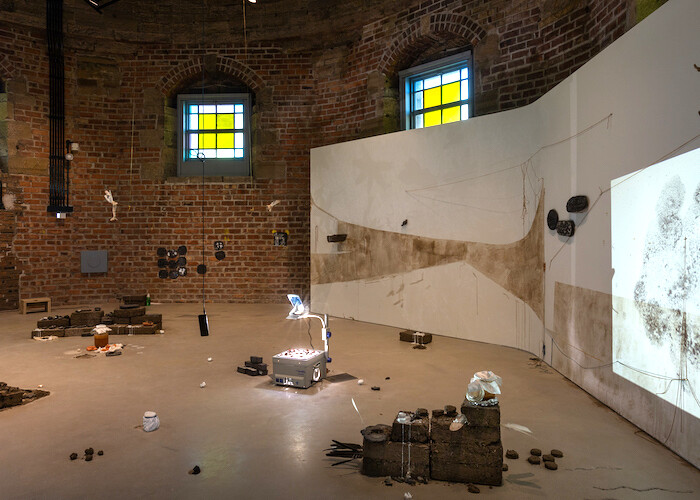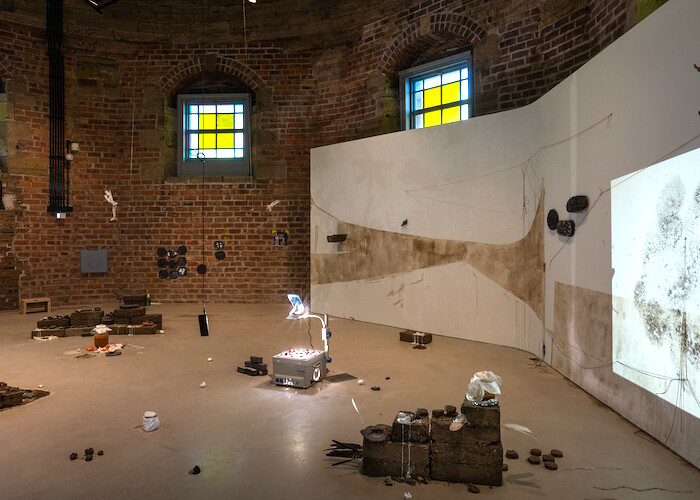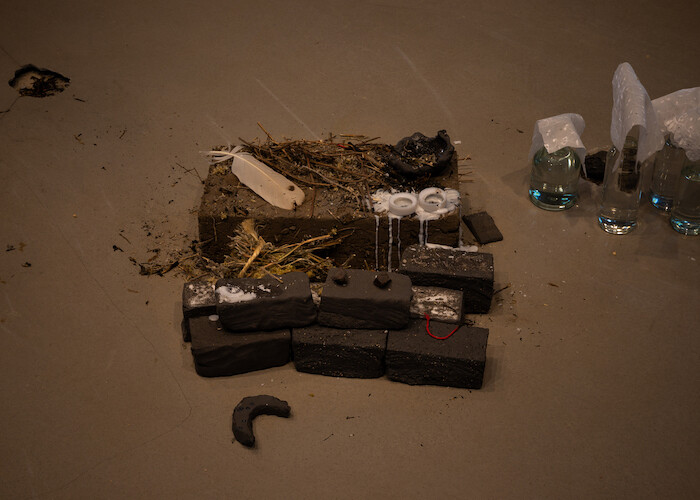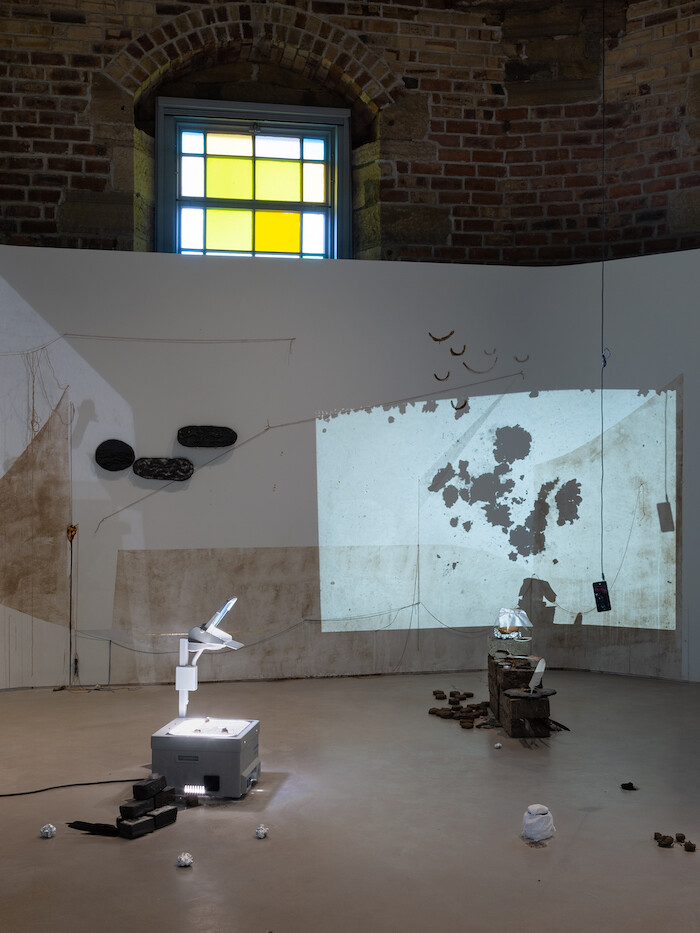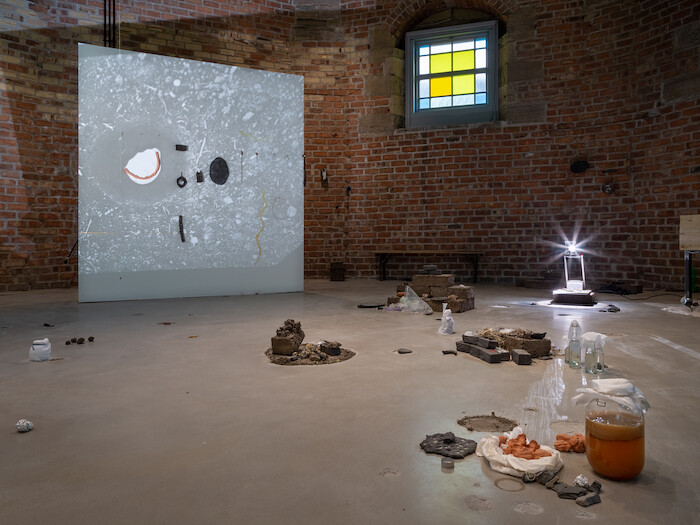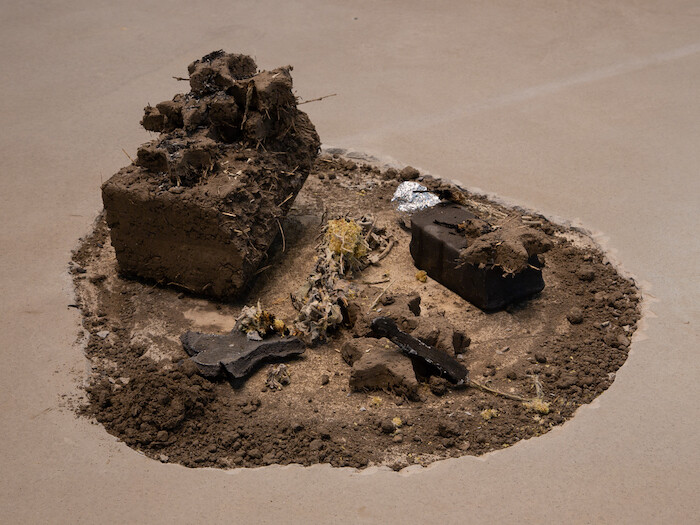At once named and unnamable, Dineo Seshee Bopape’s installation 〰️ gathers myriad references (astrology, classical sculpture, Afrodiasporic spiritual practices, the Anthropocene) and materials (soil and rocks, satin and spices, glass and plastic, charcoal, jute, feathers, clay). It weaves them together thrillingly, with gold wire, cotton thread, and lines scraped into the concrete floor. In scale, the installation oscillates from tiny holes made by drawing pins to the vastness of a universe. Seen as a single entity, this is a work that marks itself, maps itself, archives its own making and its own meanings. It is a work that prompts a pile-up of words and renders them all inadequate. All my notes are lists.
The first mystery of the exhibition is its title: a glyph designed by the artist consisting of six wavy vertical marks, represented here by the “〰️” symbol. In print it is like rising steam (or is it falling rain?). Scratched into the gallery floor, or marked in tiny biro lines on the wall, these wobbly lines read more like the Egyptian hieroglyph for water: a linguistic echo of tidal marks in sand or the flowing of a river. It does not translate into letters or sound or language; it cannot be converted into Unicode. In square brackets is a clue: [when spirituality was a baby]. This phrase reaches back toward a nascent state before belief had crystallized into institutional religions, before land ownership perhaps, before meaning itself had yet solidified.
Like many of Bopape’s expansive sculptural installations, 〰️ is almost overwhelming. There are so many things and so little space for the visitor. The octagonal City Dome, one of the buildings of the recently renovated former observatory atop Edinburgh’s Calton Hill, is not big. But the installation contains such an array of materials that they are listed on an accompanying paper: 57 of them, in alphabetical order. These materials span the globe. Bopape has brought soil from the Congo, Germany, Iceland, Palestine, and South Africa. There is citrine from Brazil and verbena from Ukraine. Deep time and a shallow present lie side by side: mammoth bones and charcoal, 225-million-year-old wood from Madagascar alongside tinfoil and plastic bottles.
It feels at first like a place of ritual: there are candles, semi-precious stones, and the smell of incense. Bopape has made dozens of clay shapes, some like tiles, others formed by the clenching of a fist. Snowy owl feathers are tied to bowed branches that hang on golden thread from the high domed roof. And, befitting of an installation that took nine months to birth, there is also life: jars of kombucha. Echoing throughout is the rhythmic clattering of a slide projector. Sometimes there is a jangle of recorded bells.
Walk in a slow spiral and 〰️ feels like a topographical model. Edinburgh stretches out below Calton Hill. But kneel and you can trace with your own fingers the marks that Bopape has clawed into the concrete. There are curving lines and craters, as if something has landed from space (there is indeed a pair of meteorites somewhere). Get close to the walls and you can see the holes left by pins and screws. There are little pencil crosses, such as gallery technicians use during installation, but they appear to be in the wrong places. To stand is to read the work like a map; to kneel is to walk in the world.
Gradually something clicks into focus. Two overhead projectors shine lights across the gallery. One is strewn with star anise: their silhouettes darken a white wall, stretch up across the bricks behind. Nearby lie groups of stars made crudely out of clay. The thing and a shadow of the thing, and the thing’s mimetic copy. But which is which? By the other projector is a transparency depicting not star anise but a constellation of stars: Canis Major, as it is known in Western astronomy. We are in an observatory after all, in the historical center of the Scottish Enlightenment.
This is a vital clue. What is a constellation but a series of lines imposed on a world to make it mean something? A constellation is a silhouette, a gathering, a metaphor, knowledge itself—the layout of Bopape’s entire installation mirrors the stars of Canis Major. Perhaps, after all, this is less about all these material objects than about the wavy lines that connect them—sound, light, language, history, truth—and who has had the power to draw them. Everything here is imbued with meaning. It seeps out across the floor, into the air, and suddenly there is no empty space: not a void between objects, but a breathy and unmappable tapestry of infinite affinities.
But only for a moment. Then the threads of signification fray (or maybe they are always fraying) and snap; sense unspools, and rational meaning—if there ever was any—lies crumbling and old and just so very, very tired, scattered across the gallery floor. This is the greatest of gatherings. It’s all falling apart.
